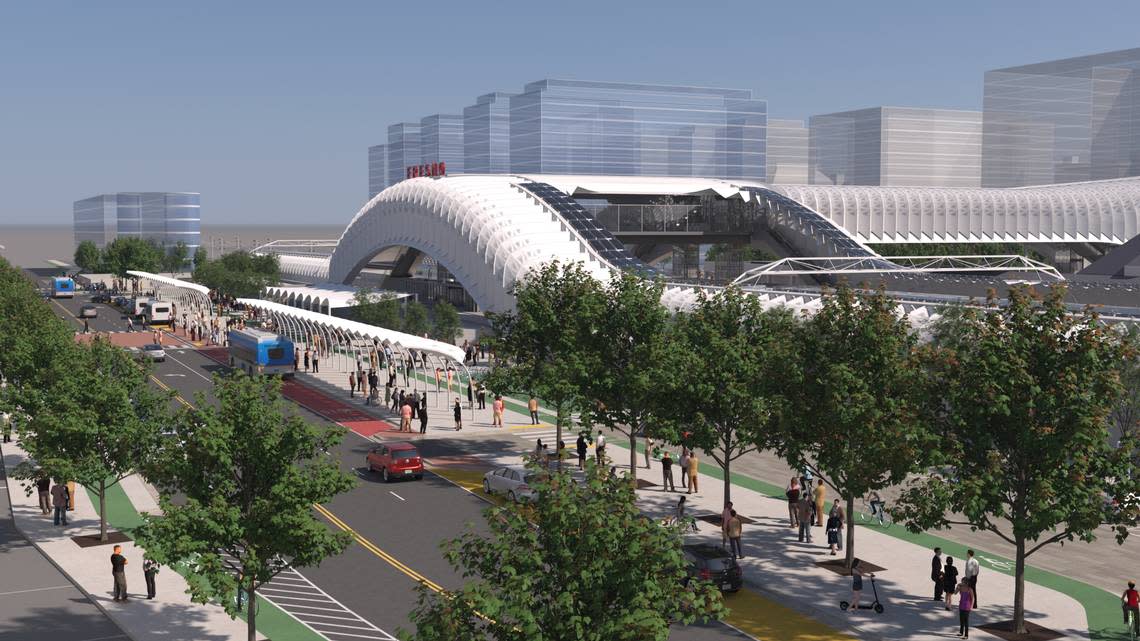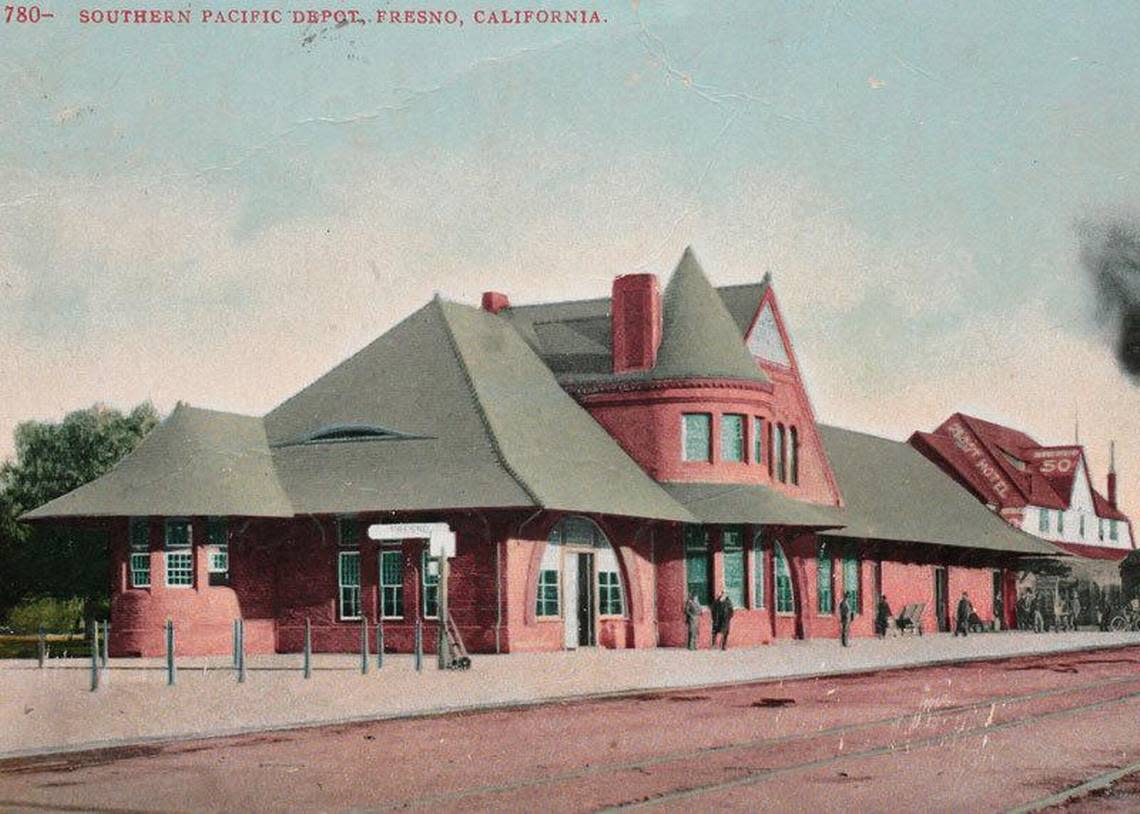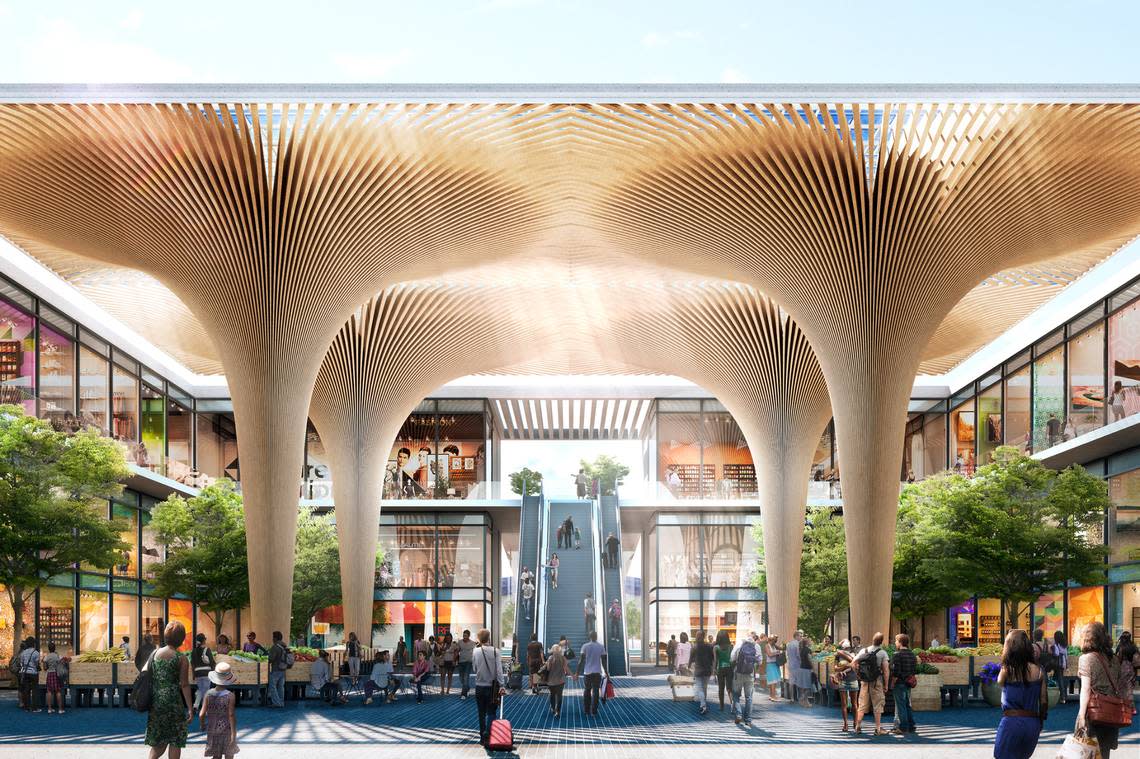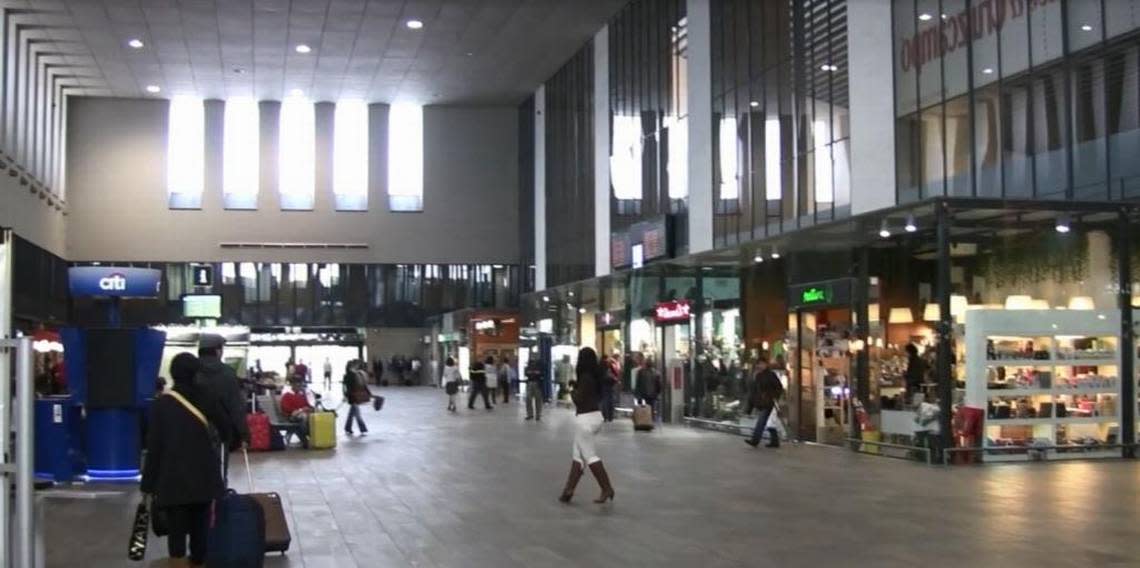Fresno has big hopes for high-speed rail to spur downtown renaissance. What’s the grand plan?
For more than a decade, city of Fresno leaders have pinned at least part of their hopes for revitalizing the beleaguered downtown and Chinatown districts on the development of a sparkling new jewel – a modern, bustling station for California’s high-speed rail system.
The California High-Speed Rail Authority’s Fresno station, currently in the design stages, will eventually be built on a site bounded by Fresno, H, Tulare and G streets, straddling the existing Union Pacific Railroad freight tracks and the future bullet-train line.
Planners with the rail agency foresee a contemporary multi-modal transportation hub with a sleek design, concourses with restaurants and retailers, a pedestrian bridge connecting downtown with Chinatown, and inviting public spaces. It will be developed in stages – first with the renovation of a historic train depot and construction of shaded plazas where people can watch new bullet trains go through testing, and later observe the construction of the larger passenger station that can expand as the rail system expands.
In the surrounding blocks of downtown and Chinatown, the city of Fresno envisions capitalizing not only on travelers disembarking from the trains but also local residents through the revitalization of neighborhoods with an array of residential, retail and entertainment venues, along with additional parking and development that complements the station itself.
“We really want it to be incredibly easy for people to take the train, but we also want it to be incredibly easy for people to walk off a train and off the platforms and into the surrounding community,” said Margaret Cederoth, director of planning and sustainability for the rail authority. “We want to be bringing people into these downtown areas.”
The station and surrounding development are a major component of Mayor Jerry Dyer’s broader plans for a vibrant downtown with as many as 10,000 residents and accompanying amenities, modernized infrastructure such as water and sewer lines, and changing the perceptions among Fresnans and residents across the central San Joaquin Valley that downtown is a desirable place to live, work and recreate.
The station site is a location dripping in Fresno’s early history: It’s where the Central Pacific Railroad built a small wood-frame depot in March 1872. It’s where a 27-year-old entrepreneur from Ohio, James E. Faber, pitched a tent in April 1872 to set up a primitive general store, becoming the first merchant and first permanent resident of what was then known as Fresno Station. He sold goods to railroad workers as they built the Central Pacific line through the Valley.

Now, 151 years later, it’s another railroad project – high-speed rail – that’s bearing the weight of expectations for downtown Fresno and the adjacent Chinatown district. Fresno will be the biggest city along what is being built as a 171-mile initial operating segment of the bullet-train project from Merced to Bakersfield, now planned for completion and operation between 2030 and 2033.
Future extensions beyond the San Joaquin Valley for a statewide, electrified high-speed rail system from San Francisco to Los Angeles remain very much on the drawing board until California can find the tens of billions of dollars needed to build them.
The city of Fresno adopted a “station area master plan” in 2018 that lays out a long-range vision for not only the high-speed rail station itself, but also for the roughly 190-acre, half-mile-square area around it, an area bounded by Van Ness Avenue, Highway 99, Tuolumne and Inyo streets. It encompasses areas that are within about a five-minute walk from the rail station itself.
It will be several years, maybe longer, before plans for the Fresno station come to full fruition.
What high-speed rail is planning
Faber’s tent is long gone, as are a string of other structures that have come and gone over the past 151 years. A building along H Street housed the Fresno Chamber of Commerce from 1903 to 1959, when it was demolished to make way for the Greyhound Bus Depot. The bus station itself was demolished in 2017 to clear the way for the planned high-speed rail station.
The Southern Pacific Railroad built its depot along the east side of the railroad tracks in 1889; that historic structure still stands today, and is being incorporated into the California High-Speed Rail Authority’s broader station plans.
The rail agency earlier this year received a $20 million grant to renovate the old depot and bring it up to modern standards while maintaining the architectural character that earned it a spot on the National Register of Historic Places. Plans call for upgrades for modern accessibility and seismic standards, as well as for two outdoor plazas – on the H Street side of the station facing downtown Fresno, the other on the G Street side facing Chinatown.
Together, the renovations to the old depot and the development of the plazas are envisioned as part of “placemaking” efforts to attract visitors to downtown and Chinatown long before the high-speed trains begin carrying passengers between 2030 and 2033.

“We want to move as aggressively as possible with that (depot) building because we see it as a great opportunity for early site activation, which is one of those concepts we’ve talked about a lot,” Cederoth told The Fresno Bee this month. “We’ve heard from the city and the local community how important it is to get pieces of the station done as soon as possible, so that the station becomes a functional part of the community.”
“We’re very focused on making sure that this site is a place where people can come to watch the construction of the station and then the testing of the trains,” Cederoth said. “We’ve learned how interested people are in watching the evolution of the system, and testing of the trains is a really critical part of that.”
Earlier this year the state put out calls for companies interested in building the electric-powered high-speed trainsets for the system, with an eye toward having two prototypes delivered for testing and commissioning in 2028.
Restoring the old depot, creating outdoor plazas, and ultimately building a station complex that can be a magnet destination for residents beyond mere transportation purposes “is one of our core ideas around stations, that even if you’re not taking a train, you want to go there, you want to do things on that broad station site,” Cederoth added.
Architectural drawings for the depot renovation and the two plazas are expected to be ready in the spring of 2024, with construction likely to commence in 2025 and be complete in 2026.
Plans for the broader high-speed rail station – a sleek edifice with sweeping lines, a landscaped and elevated terrace with a pedestrian bridge connecting not only the east and west sides of the station, but downtown Fresno and Chinatown – are moving along a somewhat more extended schedule. Two English firms were awarded a $35.3 million contract last fall to do preliminary site planning and station designs for the Fresno station and stations in Merced, Hanford and Bakersfield.
The first phase of that design contract runs into the spring of 2025. A second stage would follow for production of final designs, construction plans and construction support. “We’re looking at the delivery of a station in the 2028 time frame,” Cederoth said. “That dovetails with our timing for testing and commissioning the system and the drive to passenger service in the 2030 window.”

The state rail agency envisions a station with covered, open-air boarding platforms on either side of a substantial terminal building that includes a high atrium and places for retail shops and restaurants that serve not only train passengers, but the surrounding community — common features of high-speed rail stations in Europe and other parts of the world.
“The stations themselves should be a really good part of the public realm; they should serve as a bridge across the rail line so that you’re actually re-knitting some of these communities together,” Cederoth said. “We really think the investment in Chinatown is very important.”
What the city of Fresno is planning
Fresno gave itself a five-year head-start on its own station-area planning efforts when it adopted a station area master plan in 2018 – a recognition that “having a high-speed rail station does not alone create economic transformation,” then-Mayor Lee Brand wrote in a letter introducing the plan. “The Fresno Station District is a blueprint to create a regional hub for economic and environmental innovation within the San Joaquin Valley.”
Even before the master plan was finalized, the city was undertaking efforts to ultimately go hand-in-hand with development of the station – most notably the adoption in 2016 of a Downtown Development Code, Fulton Corridor Specific Plan and a Downtown Neighborhoods Community Plan. The combination of actions established building standards, residential densities, and permitted land uses for a 7,290-acre area in and around Fresno’s downtown core.
In October 2017, the city completed 19 months of construction to tear out the pedestrian-only Fulton Mall and reopened a restored six-block stretch of Fulton Street to automobile traffic for the first time since 1964.
The 2018 master plan details six distinct sub-areas in the blocks surrounding the rail station, with different development goals in mind for each.
A “Fulton District East Arrival” area along the Mariposa Mall from Van Ness Avenue to the rail station at H Street, bounded by Fresno Street on the north and Tulare Street to the south.
A “North Fulton Gateway” district bounded by Van Ness Avenue and Tuolumne, Fresno and H streets with infill residential development and retail.
A “South Fulton Gateway” district that incorporates the Chukchansi Park baseball stadium within an area bounded by Van Ness, Tulare, Inyo and H streets with mixed-use retail and residential development and stand-alone parking garages.
A “Chinatown West Arrival” district bounded by Fresno, Tulare, E and G streets with a new urban park, adapting historic buildings for new uses, parking garage and mixed-use retail/residential projects.
A “Historic Chinatown” district in an area bounded by Tulare, Inyo, E and G streets with infill development along F Street, preservation of historic structures, and structures along G Street that may complement the nearby high-speed rail station.
A “Chinatown West” neighborhood bounded by Fresno, Tuolumne, E and G streets with stand-alone parking structures, neighborhood mixed-use residential and retail projects, and neighborhood or community facilities.
The city is also planning, in collaboration with the state rail agency, for an intermodal transportation hub that can accommodate local transit buses, shuttles to the Amtrak station at Tulare Street and Santa Fe Avenue, electric vehicle charging stations and more “transit-oriented development” features to promote public transit and reduced reliance on automobiles.
Broadly, major changes in the area included reopening some downtown streets that were now closed to traffic, including reconnecting Mariposa Street between H Street and Federal Alley just west of Van Ness Avenue; Broadway Street between Tuolumne and Mariposa streets; and Merced Street between Van Ness Avenue and H Street.
That’s in addition to new underpasses at Ventura and Tulare streets now under construction to carry automobile traffic under the future high-speed train tracks and existing Union Pacific Railroad freight tracks, restoring connections between downtown and Chinatown that have been disrupted for several years. Those underpasses are expected to be completed in 2024. A new underpass to carry Fresno Street traffic under the UPRR and high-speed rail tracks is also planned.
Over the long term, the ambitious master plan foresees a new Fulton Street plaza and gateway into the station district at Tuolumne Street across from the Warnors Theatre; converting several lots now used for surface parking into mixed-use retail/commercial buildings along H Street; and punching Broadway Street through from Mariposa Street to Tulare Street, through what is now a building currently occupied by the Fresno Economic Opportunities Commission at Mariposa Street. A new mixed-use project would replace the EOC building west of the reopened Broadway.
“The Station Area Master Plan acknowledges Fresno’s rich history and historic relationship with rail,” Brand wrote in 2018. “It recognizes the significance of preserving the character of F Street, Chinatown’s historic main street. It focuses the station on the Mariposa Street alignment, the axis upon which all prominent Fresno civic buildings are centered.”
“It also includes two entrances to the station – one for the Fulton Corridor from the east, and one for Chinatown from the west – to ensure high-speed rail is not a physical barrier in the community but a common ground that links downtown Fresno and the surrounding neighborhoods to the region and the rest of the state,” Brand added.
The current administration under Mayor Jerry Dyer also sees the station as an important component of revitalization. More than a year ago, Dyer’s government affairs manager John Ellis told members of the California High-Speed Rail Authority board of directors in April 2022 that Fresno was eager for the agency to move forward with its station design program.
“This will bring positive change to Fresno, likely on a scale not seen since the city was founded in 1872 by the Central Pacific Railroad,” Ellis said at that time. “To state it very clearly, a vibrant station is a must. … The city is not interested in having just a platform placed in the heart of a thriving downtown.”
Adding to the momentum in downtown are two major infusions of cash from the state of California adding up to almost $300 million to help underwrite a slew of infrastructure improvements to add parking and upgrade aging sewer pipelines and water mains necessary to support the anticipated development of more residential and business projects.
Fresno’s planning effort, including for the nearby Fulton Street corridor, “has been an incredibly valuable signpost for us as we think about the big moves on the station and identifying parcels that can be transit-oriented development over time,” Cederoth said. “The city’s been a great partner. I think it’s been really smart about how the downtown can really transform, as evidenced by the money they received from the state over the summer.”

